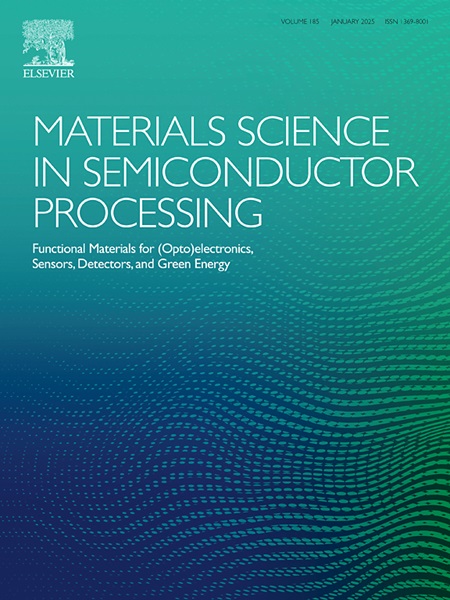利用低压远程等离子体化学气相沉积技术实现器件级砷化镓的同层外延生长
IF 4.2
3区 工程技术
Q2 ENGINEERING, ELECTRICAL & ELECTRONIC
引用次数: 0
摘要
我们利用远程等离子体化学气相沉积(RP-CVD)反应器,在 0.5 毫巴和 500 °C条件下生长出了高质量的同外延 100 GaAs 薄膜。通过这一工艺,我们展示了高达 3 μm/h 的薄膜生长速度,与传统的 MOCVD 技术相当。所制备的薄膜具有接近商用砷化镓晶片的结构特征,SAED 图样和全宽为 0.004° 的 004 峰 XRD 摇摆曲线测量结果均证实了其优异的结晶质量。原子力显微镜测量显示其表面粗糙度为 0.2 纳米,与抛光晶片的粗糙度相似。通过 XPS 表面和深度剖面测量确定的化学成分分析表明,薄膜是均匀的,整个薄膜层的 III/V 比值恒定为 1,并且没有可检测到的碳或氧污染。此外,薄膜还显示出尖锐的光致发光峰(FWHM 为 55 meV),p 型掺杂浓度为 1.1018 cm-3,空穴迁移率为 172 cm2 V-1.s-1。因此,这项工作展示了一种经济高效的 III-V 器件生长方法,在低压下进行 RP-CVD 操作时,气体消耗量降低(仅为几毫微克,而 MOCVD 则为几十升/分钟)。本文章由计算机程序翻译,如有差异,请以英文原文为准。
Homoepitaxial growth of device-grade GaAs using low-pressure remote plasma CVD
We have achieved the growth of high-quality, homoepitaxial 100 GaAs thin films at 0.5 mbar and 500 °C using a Remote Plasma Chemical Vapor Deposition (RP-CVD) reactor. With this process, we demonstrate a film growth rate up to 3 μm/h, comparable to the conventional MOCVD technique. The resulting films exhibit structural characteristics close to those of commercial GaAs wafers, with excellent crystalline quality as confirmed by SAED patterns and XRD rocking-curve measurements for the 004 peak with a FWHM of 0.004°. AFM measurements reveal a surface roughness of 0.2 nm, similar to that of a polished wafer. Analysis of the chemical composition – as determined through XPS surface and depth-profiled measurements – indicates that the film is homogeneous, with a constant III/V ratio of 1 throughout the whole layer, and has no detectable carbon or oxygen contamination. Additionally, the films demonstrate a sharp photoluminescence peak (FWHM of 55 meV), a p-type doping concentration of 1.1018 cm−3, and a hole mobility of 172 cm2 V⁻1.s⁻1. This work thus demonstrates a cost-effective growth method for III-V devices, enabled by the reduced gas consumption (only a few sccm, compared to tens of L/min in MOCVD) in RP-CVD operation at low pressure.
求助全文
通过发布文献求助,成功后即可免费获取论文全文。
去求助
来源期刊

Materials Science in Semiconductor Processing
工程技术-材料科学:综合
CiteScore
8.00
自引率
4.90%
发文量
780
审稿时长
42 days
期刊介绍:
Materials Science in Semiconductor Processing provides a unique forum for the discussion of novel processing, applications and theoretical studies of functional materials and devices for (opto)electronics, sensors, detectors, biotechnology and green energy.
Each issue will aim to provide a snapshot of current insights, new achievements, breakthroughs and future trends in such diverse fields as microelectronics, energy conversion and storage, communications, biotechnology, (photo)catalysis, nano- and thin-film technology, hybrid and composite materials, chemical processing, vapor-phase deposition, device fabrication, and modelling, which are the backbone of advanced semiconductor processing and applications.
Coverage will include: advanced lithography for submicron devices; etching and related topics; ion implantation; damage evolution and related issues; plasma and thermal CVD; rapid thermal processing; advanced metallization and interconnect schemes; thin dielectric layers, oxidation; sol-gel processing; chemical bath and (electro)chemical deposition; compound semiconductor processing; new non-oxide materials and their applications; (macro)molecular and hybrid materials; molecular dynamics, ab-initio methods, Monte Carlo, etc.; new materials and processes for discrete and integrated circuits; magnetic materials and spintronics; heterostructures and quantum devices; engineering of the electrical and optical properties of semiconductors; crystal growth mechanisms; reliability, defect density, intrinsic impurities and defects.
 求助内容:
求助内容: 应助结果提醒方式:
应助结果提醒方式:


